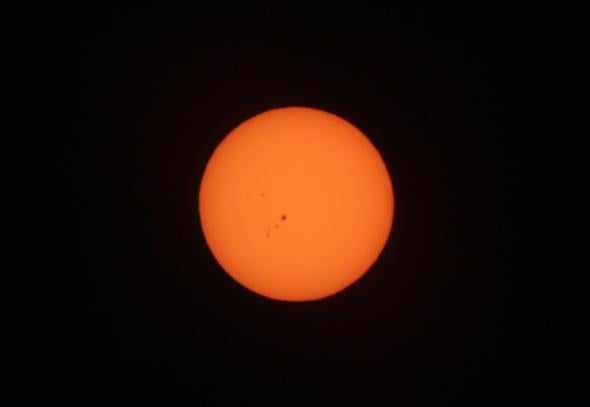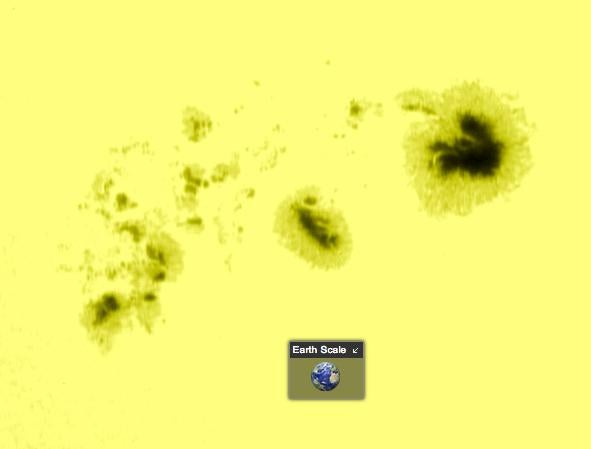A few days ago, a sunspot appeared over the western edge of the Sun. Dark and foreboding, like a malevolent eye, Active Region 1944 (or just AR1944) is huge, actually a cluster of more than 60 individual sunspots, one of which is far, far larger than the Earth itself.
It’s been cloudy here in Boulder, Colo., the past few days, but this morning it cleared up. I rigged a solar filter for my camera using some safe solar filter glasses given to me by my buddy Stephen Ramsden and went outside to brave the cold and get some shots. Here’s the best one:

Photo by Phil Plait
As you can see, the main sunspot is a bruiser. I’d estimate it as four times the diameter of Earth, or about 50,000 kilometers (32,000 miles) across—big enough to see without magnification! In fact, using “Eclipse Shades,” which are rated safe for solar viewing, I was able to see the spot easily myself. I urge folks to get a pair or three of these glasses; they’re very inexpensive and you never know when you’ll get a chance to see a monster sunspot like this one. Remember, don’t try to look at the Sun without adequate protection, and NEVER look a the Sun through binoculars or a telescope unless someone who really knows what they’re doing set it up for you.
If you’re still having trouble picturing how ridiculously big this spot is, then maybe this observation of it by the space-based Solar Dynamics Observatory will help:

Photo by NASA /SDO/Helioviewer.org
Holy magnetic bottling! That shot shows the whole active region with the Earth thrown in for scale. Even the “smallish” spots are the size of our planet.
Sunspots are areas where the Sun’s magnetic field is very active. In a nutshell, parcels of hot, ionized gas inside the Sun are buoyant and rise up (like hot air balloons). Usually they reach the surface, cool, and sink back down (this process is called convection). However, these bubbles of gas can have strong magnetic fields embedded in them, and when a bubble reaches the surface of the Sun, its magnetic field can interact with those of other bubbles. This can act like a trap, preventing the bubble from sinking once it cools. The Sun glows due to its heat, and a cooler patch will therefore look darker.
Voilà. Sunspot.
Staying up top on the Sun comes with a price, however. Magnetic field lines store vast amounts of energy, and if the lines get tangled up with those from other bubbles (or turbulence in the spot itself twists them up) they can snap, releasing that energy. This can trigger a solar flare, an explosion so powerful it dwarfs our entire nuclear arsenal into insignificance. It may also blast out a coronal mass ejection (CME), an eruption of billions of tons of subatomic particles screaming outward at hundreds or even thousands of kilometers per second.
Here’s video taken in the far-ultraviolet showing several flares erupting on the Sun in May 2013:
In general, the impact on Earth from these events is minimal; usually they just spark beautiful aurorae. However, if they’re big enough, CMEs and flares can cause havoc here. They can send power surges through satellites, causing them to shut down. They can also interact with Earth’s magnetic field, causing radio interference and even power grid failure; a CME in 1989 caused a widespread blackout in Quebec, leaving people without electricity for days.
AR1944 has already been popping off flares, and the Space Weather Prediction Center rates this spot as having a 60 percent chance of making M-class (moderate) flares, and a 25 percent chance of creating stronger X-class flares in the next few days. In fact, one previous medium-sized flare occurred on Jan. 4, which triggered a CME that’s headed for Earth. SpaceWeather.com has great video of it. This CME is not that strong (it’s expected to only set off a G1 class geomagnetic storm), but it might induce aurorae. If you live at high latitudes (and the air around you isn’t freezing out onto the ground), you might want to get out tomorrow night (Jan. 7) and take a look. Stay warm and be careful!
I may try to get more and better pictures of this sunspot as well. AR1944 will be on the earthward facing side of the Sun for another week until the Sun’s rotation sweeps it around to the other side of the star. Until then, we’ll have a great view of this enormous spot.